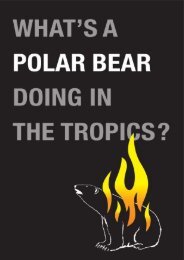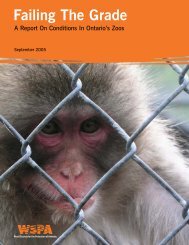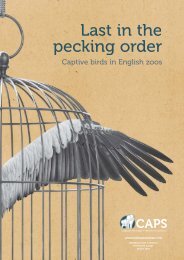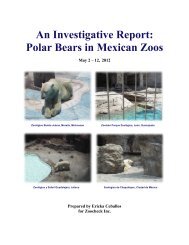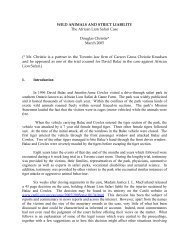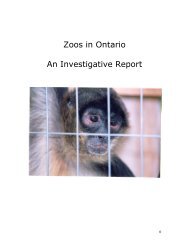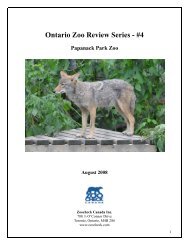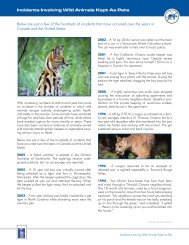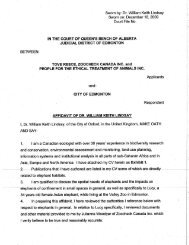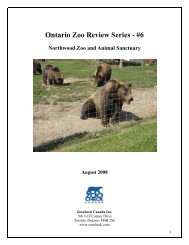STATUS OF BEAR WELFARE
STATUS OF BEAR WELFARE
STATUS OF BEAR WELFARE
Create successful ePaper yourself
Turn your PDF publications into a flip-book with our unique Google optimized e-Paper software.
Status of Bear Welfare in Cherokee, North Carolina<br />
BEHAVIORAL STRESS<br />
All bears at the Cherokee zoos were displaying classic stereotypic behavior, specifically pacing<br />
and head-weaving. These rote, meaningless, repetitive movements are typically expressed by<br />
bears who are kept in undersized, sensory-deprived conditions. Stereotypies often indicate an<br />
abnormal interaction between the bear and his or her surroundings and can be indicative of<br />
diminished welfare.<br />
Most of the bears were also actively engaged in begging behaviors, triggered when the visitors<br />
above threw food down to them. When visitors were present, the bears were standing on their<br />
hind legs, waving their paws, spinning, rolling on their backs, and/or snapping their mouths, but<br />
when the visitors moved on, the bears changed to seriously entrenched pacing and headweaving,<br />
with the exception of two of the Asiatic black bears who became inactive and lethargic<br />
and appeared depressed. For the entire duration that these bears were in their outside exhibits,<br />
they were exhibiting aberrant behaviors. The begging behavior is a complete bastardization of a<br />
bear’s normal food-gathering behavior and is a testament to the extreme lengths to which these<br />
bears have to go in order to cope on a daily basis in this substandard environment. When animals<br />
are not allowed to express their normal behavior because they live in an environment that is so<br />
alien to their genetic expectations, they are constantly forced to compromise, and the stress of<br />
doing so is extreme.<br />
Throughout the pits, numerous wear patterns were observed on the walls, indicating prolonged<br />
pacing along the perimeters of the pits as well as reaching up the walls in certain locations. The<br />
wear patterns were obvious and extensive.<br />
There was a stark contrast between the abnormal behavior of the cubs at CSBP and those at SL.<br />
The cubs at CSBP were frantic and constantly on the move, either pacing along the back wall and<br />
then throwing their head when they reached the corners, bawling at the crowd above while<br />
standing up and hanging onto the suspended tires, or climbing onto and hanging off the metal<br />
door. At the other end of the spectrum, the cubs at SL were abnormally subdued. They did not<br />
exude the high energy level, curiosity about their environment, or desire to play with their<br />
handlers or each other that cubs normally exhibit. In our professional opinion, the cubs at SL<br />
appear to have been negatively reinforced by the handlers, which could include physical<br />
punishment, in order to suppress normal play behavior during the public feeding demonstrations.<br />
Preventing appetitive behavior patterns in animals can give rise to stress and frustration and<br />
impair the development of brain regions that are involved in behavioral sequencing, thereby<br />
reducing the animals’ ability to behave flexibly and appropriately. 6 Because of the lack of<br />
appropriate natural sensory and mental stimuli, restriction of purposeful movement, boredom,<br />
lack of exercise, and loss of freedom of choice and control over their environment, animals in<br />
captivity often divert their energies and anxiety into abnormal behavior.<br />
The mammalian brain functions similarly whether it is in a human, a mouse, or a bear. Research<br />
indicates that sensory-deprived humans, such as prisoners in “Supermax” prison facilities—living<br />
in concrete cells, doing and eating the same things every day at exactly the same time—also<br />
develop serious aberrant behaviors similar to those of bears in pit enclosures. 7<br />
AN INVESTIGATIVE REPORT <strong>OF</strong> CHIEF SAUNOOKE <strong>BEAR</strong> PARK, CHEROKEE <strong>BEAR</strong> ZOO, AND SANTA’S LAND | 24



